The British Inspiration for the IDF's Sayeret Matkal - the SAS.
Commemorating the springboard for UK Special Forces invasion of Sicily built in Kibbutz Gesher HaZiv
On July 9th, 1943, thousands of soldiers of the UK’s Eighth Army, led by the famed Field Marshal Bernard Law Montgomery, stormed the beaches of Siracusa, an Italian city in southern Sicily. This was a key part of Operation “Husky”: the Allied Forces' plan to invade fascist-controlled Italy during World War II. Paving the way for the British forces were the soldiers of the Special Raiding Squadron (SRS), an elite unit specially prepared for the task. However, few know that their training and preparation were done in Israel, near what would soon be called “Kibbutz Gesher HaZiv.”
The British Special Air Service (SAS) was a commando unit founded in 1941 by Sir David Stirling. It was created to assist British forces in the desert battles of North Africa against the famed Nazi General Erwin Rommel. Their unique commando battle tactics were highly successful, destroying a record number of Nazi planes and forcing Rommel to divert large resources to combat them. Though Stirling himself was captured by the Nazis, the SAS proved to be a valuable resource in the Allied arsenal.
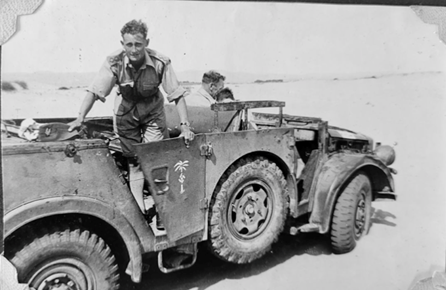
Nazi vehicle captured by the SAS. Driving the vehicle is the SRS commander, Maj. Paddy Mayne. Tonkin Collection. Courtesy, Jane Storey (2023)
Through their impressive achievements, it was clear that in order to integrate them in the Allied fight in the vastly different terrain of Europe, the SAS would have to change. The SAS was reorganized into the Special Boat Squadron (SBS) for commando sea missions, and the Special Raiding Squadron (SRS) for commando arial and raiding missions, under the command of Stirling’s deputy, Maj. Paddy Mayne. Their first mission - spearhead the British Forces invading Italy in Operation “Husky”, the first Allied invasion into Axis territory in Europe.
Preparations for the mission were critical, especially for a unit that had never fought on European soil. Fortunately, the SAS command and units found the perfect place to establish their training camps in the Land of Israel, then under the British Mandate. The SBS settled near Athlit crusader castle (used also by the legendary British Special Operations Executive, SOE) and the SRS built their training on an unpopulated hill near the village of Az Zib.
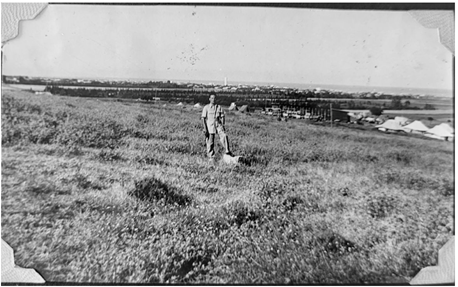
A British soldier in the SRS camp. Behind him is the Jewish Yishuv Nahariya, Tonkin collection (2022), courtesy, J. Storey.
The training there was tough. The SRS in particular trained for a range of capabilities needed to invade Italy: they practiced capturing coastal batteries in Cyprus, amphibious operations in the Gulf of Aqaba (known today also as Gulf of Eilat), ski training in Lebanon and cliff-scaling at Rosh HaNikra (a few kilometers north of their camp). In July the SAS units were ready and Operation “Husky”, was about to begin.
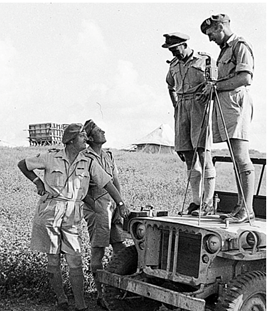
SRS personnel in Gesher HaZiv. Tonkin Collection. Courtesy, Jane Storey (2023)
The operation was a complete success. The SAS forces led the coastal battery onto the Italian beaches and continued to operate on the Italian mainland, conquering territory and liberating cities. On September 8th, 1943, the Italian regime officially surrendered to the Allied Forces. Two months later the SAS returned to Britain, where they assisted in the preparations for the Allied invasion of Normandy in 1944.
The story of the SAS became legendary, and their legacy had an impact on many elite commando units in militaries around the world. In Israel, the IDF’s elite commando unit, Sayeret Matkal, drew inspiration from the SAS, adopting their motto “Who Dares Wins.” At the end of advanced training, soldiers in the unit receive the book “The Phantom
Major”, which tells the story of the SAS and its commander David Stirling.
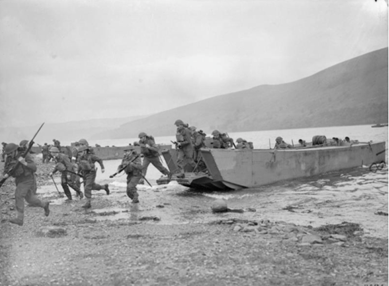
Allied soldiers stormed the shores of Sicily during Operation Husky
Finding the lost SRS training camp
Brig. Gen. (res.) Erez David Maisel served as the head of the IDF’s International Cooperation Division and today is a member of the Haganah Heritage Association. During his command of the division, he initiated the military commemoration project “Generation Arrow”. The project aims to commemorate historical events of international cooperation between the IDF and foreign armies, reflecting the contribution of international cooperation to protect Israeli civilians and achieve military goals.
As part of the project, Erez, in partnership with the British historian Mr. Paul McCue, Executive Trustee of the Secret WW2 Learning Network, began researching the presence of SAS forces in Mandatory Palestine. Through their research, they discovered something curious. While some of the British special operations bases in Israel were known and preserved, with some even transformed into bases of IDF units, the training base of the Special Raiding Squadron (SRS) was abandoned, and its location had been forgotten. Erez and Paul began a quest to find a simple answer to the question: where was the SRS base?
Erez told us of their research: “Paul McCue had traveled to Australia, to meet with the daughter of one of the commanders of the SRS, who revealed to him an album of photos from his time in Mandatory Palestine. In one of the photos, a water tower can be seen, and when Paul showed me the picture, I realized it was the famous water tower of the city of Nahariya, which means that the camp had to be close”.
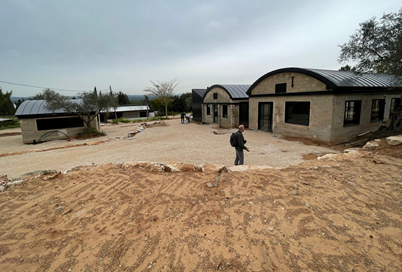
Kibbutz Gesher HaZiv today, SRS base camp 1943 - renovated camp facilities.
With this first clue, Erez and Paul began researching the area, comparing old photos to topographical maps of the area, and they found the answer: “I realized that a number of buildings in a small kibbutz called “Gesher HaZiv” have a similar design to the SRS training camp, preserved by the kibbutz, we realized we found the long-lost location of the SRS training camp, so crucial to the fight against the Axis Powers”.
On June 8th, 2023, a plaqu commemorating the story of the SRS, and of their unique training camp, was unveiled in Kibbutz Gesher HaZiv, next to a restored SRS structure in the kibbutz, currently used as a gallery. The IDF’s International Spokesperson, LTC Richard Hecht, represented the IDF in the ceremony.
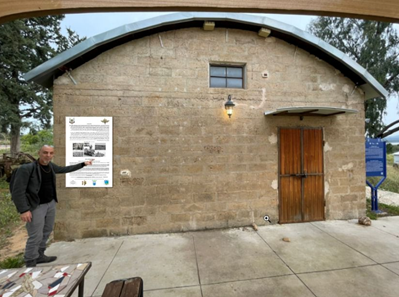
The plaque in Kibbutz Gesher HaZiv (funded by the Gerald Holdsworth Special Forces Charitable Trust), alongside Mr. Eitan Shariff, a kibbutz member who led the restoration efforts of the structure, and the establishment of an art gallery inside it.
Of the importance of commemorating such historic structures, Erez told us: “We are commemorating this place as a sign of respect to the brave soldiers who spent so much time training here, preparing for the moment where they would make history conquering Axis grounds.”
“The SAS/SRS achievements during WW2 in North Africa and then in Europe, serves as a shining example of the power of bravery, teamwork and comradery, professionalism and incredible determination in the face of tremendous challenges. An example that has inspired special forces units worldwide, including the IDF’s elite special forces unit, Sayeret Matkal, another example of joint British - Israel military heritage”.

